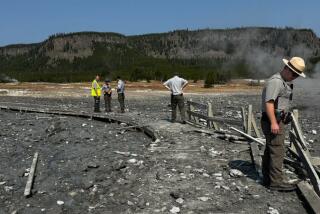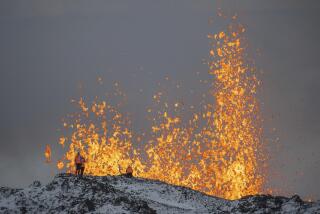Mt. St. Helens Quietly Emits a Giant Plume
- Share via
MT. ST. HELENS, Wash. — After eight days of seismic rumbling, Mt. St. Helens on Friday gave scientists and tourists what they were waiting for: a giant belch of steam and ash that rose 16,000 feet into the air before dissipating into a hazy cloud.
The event thrilled hundreds of tourists here at the Johnston Ridge Observatory, five miles north of the crater, but did little to disrupt life in southwest Washington. Airplanes flew around the plume, cars whizzed down Interstate 5, and locals mowing their lawns went right on mowing.
Officials kept the alert level at “volcano advisory,” the second of a three-step scale, with the third level indicating a major volcanic event.
Seismologists groped for words to describe the event -- calling it a hydrothermal explosion or a seismic burp -- because it didn’t fit the definition of a classic eruption involving lava and mudflows.
At 12:03 p.m., without detectable noise or tremor, a small puff of steam that looked like a cotton ball emerged from a spot inside the crater.
The puff grew in slow motion into a column, and continued to grow for another 20 minutes. The wind blew the column toward Portland, Ore., 50 miles southwest, but within an hour, the column was gone and scientists doubted any ash would reach the city.
As the cloud cleared, scientists in helicopters were able to photograph the “source hole” where the steam punched through. The hole, about 100 feet in diameter, was on the southeast edge of a 900-foot-tall lava dome inside the crater. The dome, made of layers of once-molten rock, has been slowly building since a series of eruptions in the 1980s.
The event culminated more than a week of small but increasingly intense earthquakes that originated deep inside the crater. The largest quakes occurred Thursday and Friday morning, reaching a magnitude of 3.3.
Scientists differed on what might happen next. University of Washington seismologist Tony Qamar said that even if small quakes continue, it’s possible the most dramatic part of this episode might be over because most of the pressure has been released.
But Jon Major, a geologist with the U.S. Geological Survey, which runs the observatory, said, “My guess is this is the opening salvo. We’ll probably see more like this.”
The prospect of more explosions probably means a continuing flow of tourists to the mountain, which sits in the middle of the Gifford Pinchot National Forest.
The number of visitors to Johnston Ridge has increased steadily since the volcano began quaking Sept. 23. Forest Service employees said that they were considering keeping the observatory open beyond Oct. 31, when it usually closes for the season.
For much of the week, scientists had been predicting a small to moderate eruption, which attracted tourists who wanted to witness relatively safe volcanic activity.
“I came here to watch it blow up!” said an exuberant Kay Robb, 66, who traveled to the observatory with her husband, Jim, from Kennewick, Wash. It was almost a four-hour drive for them. The couple was joined at the observatory by hundreds of other tourists, including numerous busloads of students from the Seattle area.
The increased traffic has been welcomed by businesses along the 50-mile stretch of Highway 504, which runs between Interstate 5 and the observatory.
More traffic means more customers for places such as the Silver Shores Resort Bar.
The bar sits right off the highway, and offers a distant but unobstructed view of the volcano. When the explosion occurred Friday, more than 15 carloads of people stopped, took pictures from the deck, and many had drinks to mark the event.
“It’s not that big a deal for locals like me, but for tourists, this is history for them,” said bartender Sue Eggbert.
Allen Pace, 60, dressed in black motorcycle leather from neck to ankle, is a regular at Silver Shores. He lived near here in 1980, when Mt. St. Helens erupted, killing 57 people, leveling 150 square miles of forest, and sending ash across the globe. The explosion blew off the top 1,300 feet of the peak, reducing the mountain to its current height of 8,364 feet.
Pace and his family evacuated then. But not this time, nor ever again, he said.
“I’m 60 years old. I’ve got 13 1/2 acres and my animals,” Pace said. “That’s all I’ve got now, and I won’t leave. No matter what. I’ll go down with the ship if I have to.”
Up the road, in the town of Toutle, a group of teenagers skateboarding in the high school parking lot said they were more intrigued by the steady flow of reporters and media trucks through town than by the volcano activity.
Drew Berezo, 14, said he found himself in a long check-out line at a grocery store -- something that never happens -- behind “a bunch of people who didn’t speak English.” He said he thought they were reporters from Japan or China.
Berezo and his friends said they didn’t feel a strong urge to see the volcano. They could see it any time they wanted.
“Last night, my stepdad said, ‘Let’s go up to the mountain,’ ” Berezo recalled. “ I said, ‘You do that. I’m going to stay home and play video games.’ ”
More to Read
Sign up for Essential California
The most important California stories and recommendations in your inbox every morning.
You may occasionally receive promotional content from the Los Angeles Times.













